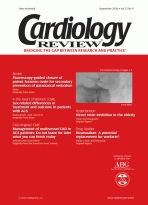Sex and ischemic stroke in atrial fibrillation
More than 15 years ago, atrial fibrillation was shown to be an independent risk factor for ischemic stroke in the Framingham study.
More than 15 years ago, atrial fibrillation was shown to be an independent risk factor for ischemic stroke in the Framingham study.1 After adjusting for age, the presence of atrial fibrillation makes individuals 5 times as likely to have a stroke as nonfibrillators, with an even greater incidence in conjunction with congestive heart failure or hypertension. Even in a population of subjects older than 80 years of age, atrial fibrillation remained a predictor of higher rates of stroke.
It was subsequently shown that anticoagulation therapy with warfarin (Coumadin) can significantly reduce the risk of thromboembolic events in patients with atrial fibrillation. However, treatment with warfarin is not completely benign, with an increased incidence of cerebral hemorrhage and other bleeding complications in patients receiving this therapy. There is also a danger of more severe injuries after falls in an older population taking warfarin because they are prone to have problems with balance. When it was shown that aspirin can also lower the chance of having an ischemic stroke but not as effectively as warfarin, the question was raised of whom to place on warfarin and whom to treat with aspirin. Thus, risk stratification was seen as being important—determining who would benefit most from warfarin with its attendant risks and who would benefit most from aspirin.
A number of studies have provided stratification of risk in atrial fibrillation to help clinicians select treatment. The CHADS2 classification, which uses the presence of congestive heart failure (C), hypertension (H), age older than 75 years (A), diabetes mellitus (D), and prior stroke (S) as predictors of stroke, appears to be a reasonable guide to evaluating risk.2 As patients’ CHADS2 scores increase, they are at greater risk for stroke. Still, the question remained whether there were other parameters that could be used in addition to CHADS2 to zero in on those patients who were at the greatest risk for stroke and could benefit most from anticoagulation therapy.
Cardiology Review
In this issue of , Fang and colleagues have added another factor to those that increase the risk of thromboembolic events in patients with nonvalvular atrial fibrillation—sex. Among 13,559 adults with nonvalvular atrial fibrillation who were not taking warfarin and were followed over 15,494 person-years to determine the incidence of thromboembolism, 394 ischemic strokes and peripheral embolic events occurred. Women were discovered to have a much higher rate of thromboembolism when not taking warfarin (3.5% for women vs 1.8% for men). When taking warfarin, the incidence of thromboembolism was almost the same for both sexes, and hemorrhagic complications were comparable. When subjects were taking warfarin, the mortality rates were much lower in both sexes and were about the same for men and women. Although previous studies have been contradictory in terms of sex risk, with only 1 report showing an increased risk of thromboembolism in women over age 75,3 the current study shows a heightened risk for women with atrial fibrillation. Added to the other risk factors noted, this would indicate a greater urgency to institute anticoagulant therapy in women with atrial fibrillation.
The mechanism of the increased risk of thrombeombolism in women with atrial fibrillation is unclear. Interestingly, in the group of subjects in the current study, men had a higher incidence of coronary heart disease and diabetes, whereas more women had a history of prior strokes or hypertension. Although prior strokes may have greater predictive value for future strokes than the other conditions, all were controlled in assessing sex as an independent risk factor. The need to treat women with atrial fibrillation aggressively with anticoagulation therapy has been shown by this large study.
